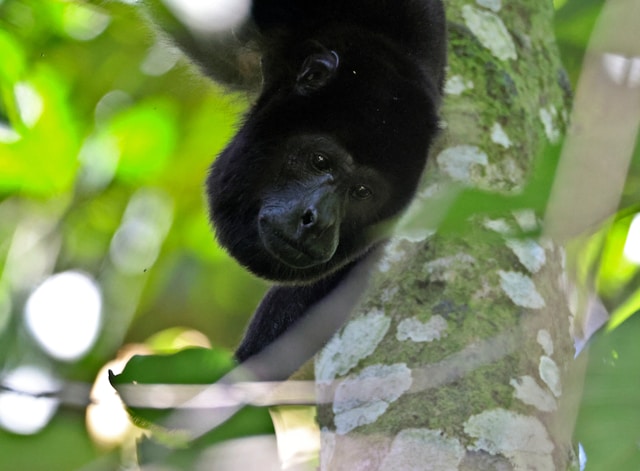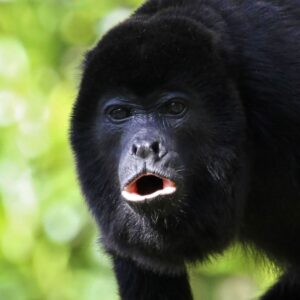In the lush rainforests of Belize, a primal symphony echoes through the trees, carried on the powerful voices of Howler Monkeys. These enigmatic primates, known for their distinctive howling calls, are not just inhabitants of the jungle but guardians of its rich biodiversity. Their vocalizations pierce through the dense foliage, marking territories, communicating threats, and establishing their presence in this verdant paradise. Join us as we delve into the world of Belize’s Howler Monkeys, exploring their majestic vocalizations, ecological significance, and the challenges they face in a rapidly changing environment.
Majestic Vocalizations: Decoding the Meaning Behind Howler Monkey Calls
The cacophony of Howler Monkey calls reverberates through the Belizean rainforest, a testament to their social complexity and communication prowess. These primates, with their distinctive vocalizations, create a sonic landscape that is both mesmerizing and informative to those who listen closely.
At first glance, the deep, guttural howls of Howler Monkeys might seem like simple expressions of dominance or territoriality. However, scientists have unraveled a more nuanced understanding of these vocalizations, revealing a sophisticated language that serves multiple purposes within their social structure.
One of the primary functions of Howler Monkey calls is territorial defense. Male Howlers, with their larger bodies and robust vocal abilities, use their deep, booming calls to announce their presence and assert dominance over their territory. These calls can travel for several kilometers, effectively warning neighboring troops to steer clear of their domain.
In addition to territorial defense, Howler Monkey calls play a crucial role in social cohesion within troops. Each troop has its unique vocal repertoire, allowing members to identify one another and maintain social bonds. Mothers and infants, in particular, use softer calls and grunts to communicate and strengthen their maternal bonds.
Moreover, Howler Monkey calls serve as an early warning system against potential threats. Alarm calls, distinct from their territorial howls, alert troop members to the presence of predators such as jaguars or eagles. The collective response to these alarms, with monkeys quickly retreating to safety, showcases their ability to communicate danger effectively.
Beyond immediate communication, the frequency and intensity of Howler Monkey calls can also reflect the overall health and status of a troop. Studies have shown that stressors such as habitat fragmentation or human disturbances can lead to changes in their vocal patterns, highlighting the interconnectedness between Howler Monkeys and their environment.
In essence, the howling symphony of Howler Monkeys in Belize is not just a primal sound but a complex language that speaks volumes about their social dynamics, environmental awareness, and resilience in the face of challenges.
Ecological Significance: How Howler Monkeys Shape Belize’s Rainforest Ecosystems
Within the intricate tapestry of Belize’s rainforests, Howler Monkeys emerge as key architects, shaping the very fabric of their habitat through their behaviors and interactions. Their ecological significance extends far beyond their vocal prowess, influencing vegetation dynamics, nutrient cycling, and the overall biodiversity of the region.
One of the most notable contributions of Howler Monkeys to Belize’s ecosystems is their role as seed dispersers. As they move through the canopy in search of food, Howlers consume a variety of fruits and leaves. In the process, they inadvertently transport seeds across considerable distances, facilitating the regeneration of plant communities and promoting genetic diversity within the forest.
Moreover, the dietary preferences of Howler Monkeys have a direct impact on vegetation structure and composition. Their selective feeding on certain plant species can influence the abundance of those species and create microhabitats that support a diverse array of flora and fauna. This selective browsing behavior contributes to the mosaic of habitats found within Belize’s rainforests, fostering biodiversity at various scales.
Additionally, Howler Monkeys play a crucial role in nutrient cycling within their ecosystems. Through their consumption of fruits and foliage, they contribute to the input of nutrients into the soil through their droppings. This nutrient enrichment supports the growth of plants and trees, further enhancing the productivity and resilience of the forest ecosystem.
Furthermore, the presence of Howler Monkeys can have cascading effects on other species within their habitat. Their vocalizations, for example, can attract insectivorous birds that follow the monkeys to feed on insects disturbed by their movements. This interplay between Howler Monkeys and other fauna creates a complex web of ecological interactions that sustains the vibrancy of Belize’s rainforest communities.
In essence, Howler Monkeys are not just inhabitants of Belize’s rainforests but vital contributors to the ecological balance and functioning of these precious ecosystems. Understanding their role and conservation needs is paramount to safeguarding the biodiversity and resilience of Belize’s natural heritage.
Conservation Challenges: Balancing Human Interactions with Belize’s Howler Monkey Population
While Howler Monkeys play a crucial role in Belize’s rainforest ecosystems, their survival is increasingly threatened by human activities and habitat fragmentation. Conservation efforts face significant challenges in balancing the needs of local communities with the protection of Howler Monkey populations, highlighting the delicate interplay between human development and wildlife conservation.
One of the primary conservation challenges facing Howler Monkeys in Belize is habitat loss and fragmentation. As human populations expand and agricultural activities encroach into forested areas, Howler Monkey habitats are increasingly fragmented, leading to isolated populations and reduced genetic diversity. This fragmentation can disrupt essential ecological processes, such as gene flow and migration, putting populations at risk of local extinction.
Moreover, human-wildlife conflict poses a significant threat to Howler Monkey populations. As forests are cleared for agriculture or urban development, Howlers may venture into human settlements in search of food or resources, leading to conflicts with local communities. These conflicts can result in retaliatory killings, habitat destruction, or the capture of Howler Monkeys for illegal wildlife trade, further exacerbating population decline.
Furthermore, the expansion of infrastructure projects, such as roads and highways, can create barriers that fragment Howler Monkey habitats and increase their vulnerability to poaching, accidents, and population isolation. The noise and disturbance from these infrastructure developments can also disrupt Howler Monkey behavior, affecting their foraging patterns, communication, and reproductive success.
Climate change adds another layer of complexity to the conservation challenges faced by Howler Monkeys in Belize. Shifts in temperature and rainfall patterns can alter vegetation dynamics, food availability, and habitat suitability for these primates. Adapting to these changing environmental conditions requires proactive conservation strategies that consider long-term climate resilience for Howler Monkey populations.
Addressing these conservation challenges requires a holistic approach that integrates habitat protection, community engagement, sustainable land use practices, and climate adaptation measures. By fostering coexistence between humans and Howler Monkeys and promoting ecosystem stewardship, we can ensure the continued survival and well-being of these iconic primates in Belize’s rainforests.
Final Thoughts
The Howler Monkeys of Belize stand as emblematic figures of the intricate balance between wildlife conservation and human development. Their majestic vocalizations, ecological significance, and the challenges they face underscore the importance of concerted conservation efforts and sustainable practices to ensure their continued presence in the rich tapestry of Belize’s rainforests.
As we delve into the world of Howler Monkeys, it becomes evident that their vocal symphony is not just a captivating sound but a language that speaks of their social dynamics, environmental awareness, and resilience in the face of adversity. Their calls echo through the canopy, signaling territorial boundaries, fostering social cohesion, and alerting to potential threats—a testament to their adaptability and communication prowess.
Beyond their vocal prowess, Howler Monkeys play a vital role in shaping Belize’s rainforest ecosystems. As seed dispersers, vegetation influencers, and nutrient cyclers, they contribute to the biodiversity and resilience of these precious habitats. Their presence creates a ripple effect, influencing the abundance and distribution of flora and fauna, showcasing their interconnectedness with the web of life in the rainforest.
However, the conservation challenges facing Howler Monkeys highlight the urgent need for collaborative action. Habitat loss, human-wildlife conflict, habitat fragmentation, and climate change threaten their survival. Finding a balance between human activities and wildlife conservation is crucial, necessitating sustainable land use practices, community engagement, and proactive conservation strategies.
In conclusion, the future of Howler Monkeys in Belize hinges on our collective efforts to protect their habitats, mitigate human-wildlife conflicts, and address the impacts of climate change. By embracing a holistic approach that prioritizes ecosystem health, biodiversity conservation, and coexistence with wildlife, we can ensure a harmonious future where Howler Monkeys continue to thrive in the verdant landscapes of Belize’s rainforests.




